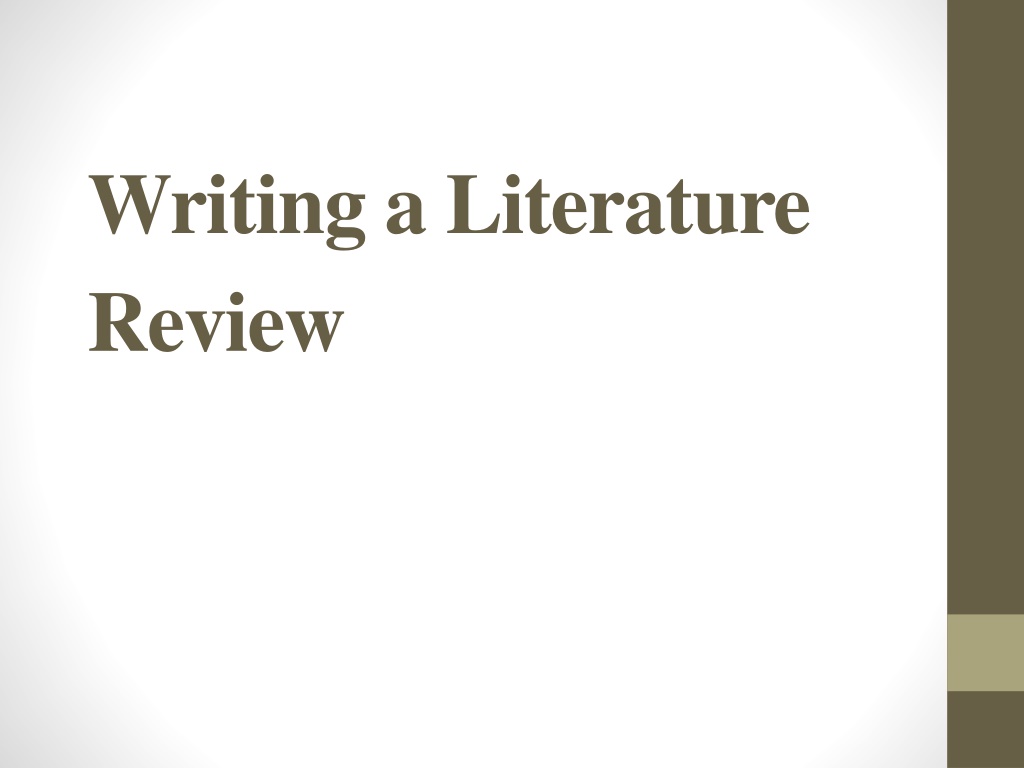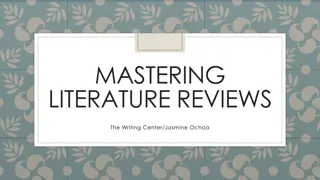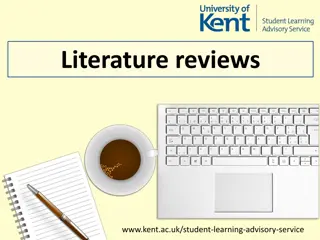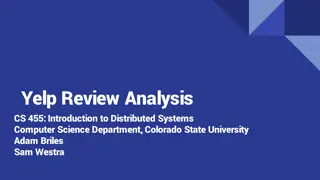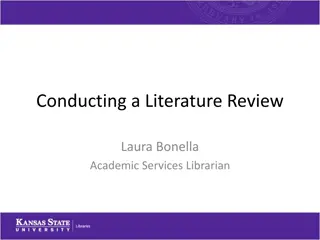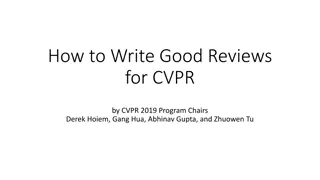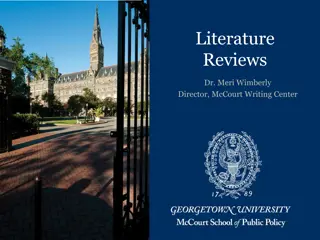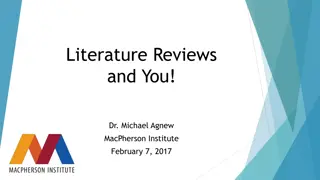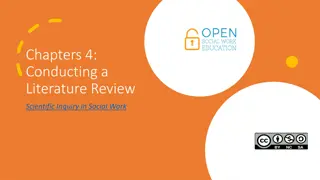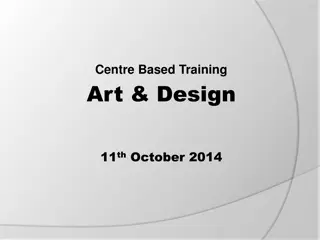Mastering the Art of Writing Literature Reviews
Understanding the essence of a literature review, its descriptive and analytical components, selecting key articles, and finding relevant sources are essential steps in crafting a comprehensive literature review. By integrating ideas from various sources and highlighting crucial findings, a literature review contributes to the depth of research on a specific topic.
Download Presentation

Please find below an Image/Link to download the presentation.
The content on the website is provided AS IS for your information and personal use only. It may not be sold, licensed, or shared on other websites without obtaining consent from the author.If you encounter any issues during the download, it is possible that the publisher has removed the file from their server.
You are allowed to download the files provided on this website for personal or commercial use, subject to the condition that they are used lawfully. All files are the property of their respective owners.
The content on the website is provided AS IS for your information and personal use only. It may not be sold, licensed, or shared on other websites without obtaining consent from the author.
E N D
Presentation Transcript
Writing a Literature Review
Overview What is a literature review? Selecting Articles to Review Structure of a Literature Review
What is a literature review? A literature review is a summary and critical analysis of writings by scholars on a particular topic/theme. A literature review, however, does not simply reproduce/summarise the literature; it is both descriptive and analytical.
What is a literature review? DESCRIPTIVE Discuss the most widely accepted findings on the topic. State the most widely accepted definitions of concepts, hypotheses etc. in relation to your topic. Identify the methods used to make and support the findings in the literature. Establish the most recent authoritative theory on the subject.
What is a literature review? ANALYTICAL The integration of ideas from different sources, highlighting differences and similarities. Showing the relevance of the literature to your research topic. (how it supports & is contradictory to your main hypothesis) Illustrate which arguments are most important/ pertinent in the field of study using examples/primary sources to do so.
Selecting Articles to Review The aim is not to discuss every single article, but the major opinions/themes on the topic. The main articles you should aim to use in your review are the seminal articles, referenced by most authors in the particular field/topic you are researching.
Selecting Articles to Review It is difficult to discuss the following topics without these authors: Authority: Weber Separation of Powers: Gwyn Democracy: Huntington
Finding Sources: The UCT library website has a link to a database (ISI Citation Database) which can find all other articles which have cited a particular article. - Go to cited reference search - Type the author s last name, the journal & year in which the article appeared in the appropriate boxes - This will give you a list of authors and articles which have followed or disagreed with the author. Google Scholar ( Cited by link) and the Academic Search Premier on the UCT library website ( cited references link) have similar functions.
Selecting sources Preview: Go through the titles of the readings, narrow down to the ones you think are most relevant. Read: The title and author details, the abstract (if there is one), read the main headings and subheadings and any highlighted text, examine any illustrations and graphs tables or diagrams and their captions
Selecting sources Overview Skimming: run through the text quickly in order to get a general idea of what it is about. Scanning: look for certain words or points in the text, rather than an overall idea of the text.
Selecting sources Inview Intensive reading, allows for a deep understanding of the final texts you ve chosen. This refers to reading the whole text and making notes of the key points.
Structure of a Literature Review Introduction The Neopatrimonial School refers to literature that attributes Africa s poor political and Neopatrimonialism, which is said to have weakened the state s capability to foster development and economic growth. Increasingly arguments have emerged which challenge this view on the basis of the very utility of the concept as an explanatory tool in Africa. The main argument is that neopatrimonialism merely describes the style of governance in a country, but does not indicate the type of strategies or policies a state will pursue and with what success. This paper aims to review these two contrasting sets of literature in order to illustrate that Neopatrimonialism does underdevelopment. The review first highlights the main arguments of the neopatrimonial school and critiques these arguments by reflecting on the contrasting emerging literature. economic record to not necessarily lead to
Structure of a Literature Review Chronological Developmental States in Africa i) 1964-1989: the authoritarian advantage: the success of the East Asian Tigers. ii) 1990- date: democracy is crucial to development: democratic developmental states.
Structure of a Literature Review Thematic Understanding Botswana s Economic Growth Literature on this topic cites the following main themes: i) Good Leadership ii) Resource Wealth iii) Foreign Aid/Assistance
Structure of a Literature Review Methodological Measuring Development A social lens versus a more economic approach to measuring development and how that affects the conclusions made in the different sets of literature Sen s Development as Freedom vs Measuring development through GDP growth.
Main Tips - Summarise the articles with as much detail as each article merits. - Identify consistent patterns and points of agreement & inconsistencies, disagreement & unresolved issues across these texts to establish what is known. - Read widely but make sure to only use the most significant and relevant sources of information to date. - Each paragraph should have a topic sentence and a clear main idea. - Pay attention to the vocabulary you use to aid in your overall analysis.
Conclusion - Summary of what you have drawn from the literature: e.g. major methodological flaws, gaps in the research, inconsistencies in the findings and therefore areas that are pertinent to future study of the topic. - Where might the discussion proceed; identify the gap your work will fill/ if your purpose was simply to identify the gaps in the literature, discuss the importance of filling these gaps. - Remember to: maintain the focus established in your Introduction.
This presentation is licenced under the Creative Commons Attribution 2.5 South Africa License. To view a copy of this licence, visit http://creativecommons.org/licenses/by/2.5/za/ Or send a letter to Creative Commons, 171 Second Street, Suite 300, San Francisco, California 94105, USA. 18
